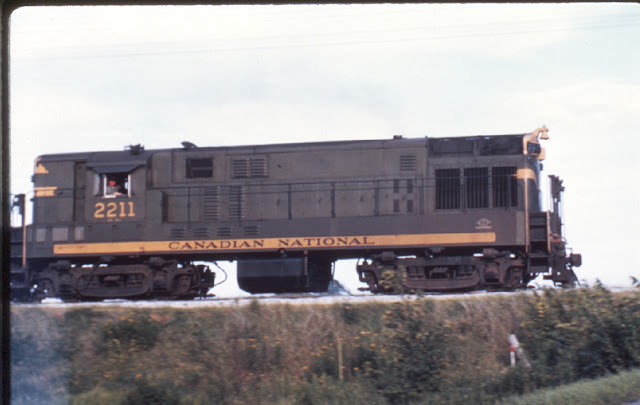 |
| The Richford Turn leaves Enosburg enroute for Richford during Session #1. |
Last Sunday was hot and muggy (though downright pleasant compared to today!) - the perfect weather to retreat to the basement where it's always a pleasant sunny day in mid October in northern Vermont! The occasion was operating session 1.0 on the Richford Branch.
I invited three good friends over to put the layout through its paces. I was concerned there wouldn't be enough to do to keep them entertained and occupied, but was pleasantly surprised to find that wasn't the case. In the end the layout supported an enjoyable, low key session for three operators and could have handled a fourth operator if only there had been another throttle available.
Operating the layout solo over the last couple of years revealed that working the town of Richford itself can easily consume an hour or so - the paper mill another hour or so - meaning it might take the branchline local 4 hours+ to finish its run over the entire layout.  |
| Bernie ponders his next move with the mill job. |
My original intention for this session was to have two trains, each with a two-person crew - one working the paper mill job, the other running the branchline local around the rest of the layout. But that would still require the branchline local to work Richford yard.
So we tried something different and created a Richford yard job that spotted and sorted the cars for the local when it pulled into town. Not entirely prototypical for my era, (it was done that way in earlier eras) but it worked out really well.  |
| Todd brings the Richford Turn into Richford as Bill looks on. |
It worked out so well I think we'll stick with this lineup for the foreseeable future:
1. Richford Turn (the branchline local)
2. The Mill Job - works the paper mill
3. Richford Yard Job
4. The Charlton Turn - works the "northern SNE" section of the railroad.
We also discussed the possibility of breaking the milk cars into a separate train. Depending on how many people we have I might try doing that next time. The Richford Turn has a lot of do as it is, and shifting the milk traffic to its own train may prove an ideal solution.
There were no issues with anyone feeling cramped or crowded - a function of mostly 3+ foot aisles in many places. That also means I can accommodate more operators by going to two-person crews in case, for example, a group of people come from out of town to operate.  |
I was giving serious consideration to removing the paper mill peninsula and lengthening the Richford peninsula and adding a turnback curve that would loop around into more staging. Based on the feedback from the operating crew, the paper mill stays - for now.
|
That covers number of trains and operators - but did the layout offer sufficient play value? I was somewhat concerned people would find it boring to operate, they would be done in 15 minutes and wondering what they were supposed to do the rest of the day.
In the end I didn't need to worry - the layout kept us busy for the better part of 2.5 hours. And everyone finished about the same time.
How did the layout perform?
In short, there were a couple of little glitches, but nothing overwhelming. Likely since I’ve been running the layout on and off for a few years.
A few gremlins did raise their heads - nothing horrible but enough to need some attention.
For example, I'm going to fix (ie, replace!) a turnout in Berkshire that just doesn’t want to cooperate. And Todd managed to find the one spur where the feeders were loose (or not there!) so I need to deal with that. And the track in Charlton needs a good cleaning.
The only other “issues” were one or two cars with coupler issues. I put them aside and will deal with them before they go back on the railroad.
The only other thing I need to deal with is upgrading some of the operator aides - apparently my handwriting hasn’t improved since grade school!
All in all a great time was had by all - thanks to Stic for all his help getting us to this point (unfortunately he was out of town so he missed this one) and to Bernie, Bill, and Todd for bringing the Richford Branch to life!
And I posted a new video update on the layout, that shows some of the progress on a couple of structures and provides a hot wash of the operating session #1. You can find that on You Tube at:
https://youtu.be/gww1AGRdOJU?si=S7JHRQzSGxN2AJKp




































